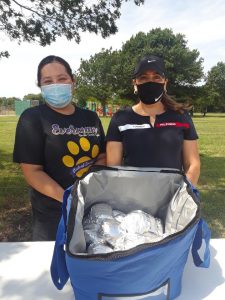Give Back by Wasting Less
At a time when 1 in 6 children are hungry, taking a few simple tips to reduce food waste will not only save money, but it can also give back to those individuals and families in need.
Read MoreNeighborhood food drives are a great way to get children involved in their communities by teaching them where their food comes from, increasing food access, and learning how to plan an event in the community.
 A neighborhood food drive is a great way to stock the shelves at local food pantries, connect with schools and other organizations to build community engagement, and keep children fed during the summer when school meal programs may be harder to access. They support many community organizations that strive to make nutrition more accessible by bringing together members of all corners of the community. Not to mention, food drives offer children opportunities to take leadership and develop skills in relationship building, empathy, and social awareness.
A neighborhood food drive is a great way to stock the shelves at local food pantries, connect with schools and other organizations to build community engagement, and keep children fed during the summer when school meal programs may be harder to access. They support many community organizations that strive to make nutrition more accessible by bringing together members of all corners of the community. Not to mention, food drives offer children opportunities to take leadership and develop skills in relationship building, empathy, and social awareness.
Choose an Organization: The first step in planning a neighborhood food drive is deciding who the families and children would like to help with their efforts.
Include Children in the Planning Process: After deciding what organization the children would like to benefit with their community food drive, it’s time to start planning!
The Logistics: Once the organization has conveyed its needs to the families or schools, it’s time to figure out what the next steps are.
Let’s Talk About SEL and Leadership: Planning the neighborhood food drive is a great opportunity for school-aged children to develop their leadership skills while participating in service learning opportunities that expand awareness and support the development of more socially-conscious members of society.
Try to advertise the food drive in places all community members have access to and often visit. This can include town squares, city billboards, presented through loudspeakers at sporting events, and online.
Encourage all children to join the planning board for the food drive by asking teachers to connect directly with students, advertising on the school’s website and front billboard, at various community centers, and sharing information with parents and caregivers.
Create a fun name or theme for the food drive to excite students and families!
Food pantries may already be hosting their own food drives. Get involved with these events as a volunteer, coordinator, or outreach member and encourage children to do so as well!
It may be helpful to reach out to local TV or radio stations to spread the word about the food drive you are planning.
And most importantly, have fun engaging with your community!
For more activities and ideas like this one, be sure to sign up for our news and updates. And if you like what you see, please donate to support our work creating more ways to help build a healthier future for kids.